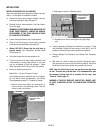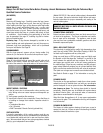
TROUBLESHOOTING Qualified Technicians Only
(ALL MODELS)
PAGE 23
PROBLEM
CAUSE(S)
SOLUTIONS
1) Pilot will not light, and Piezo Igniter does not
produce a heavy blue spark.
a. Electrode wire (at Piezo Igniter) not pushed
completely on.
b. Piezo igniter is defective
• Make sure connections are solid.
• Replace piezo igniter.
2) Pilot will not light, but Piezo Igniter produces a
heavy blue spark.
a. Incorrect lighting procedure.
b. No gas to appliance due to shut valves or dis-
connected gas lines.
• Carefully follow the lighting / operating in-
structions found in the appliance of this
owner's manual.
• Check for multiple gas shut-offs; check gas
supply lines.
3) Pilot will not stay lit. a. Thermocouple is not firmly connected to control
valve.
b. Pilot flame is not directed to top of thermocou-
ple.
c. Thermocouple is defective. Make sure connec-
tion is solid.
• Ensure thermocouple is fully inserted into pilot
assembly.
• Replace thermocouple.
4) Pilot flame stays lit, but main burner will not
light.
a. Burner control switch (on control panel) is in
"OFF" position; or thermostat (if installed) is
turned off or temperature setting is too low.
b. Electrical wiring is damaged or poorly con-
nected
c. One of the following components may be de-
fective: burner control switch, thermostat, vent
spill switch, or thermopile.
• Position the burner control switch to "ON"; or
adjust the thermostat. Refer to manufacturer's
instructions for thermostat.
• Refer to Control and Safety Wiring Diagram
(page 22) and check electrical connections.
• Refer to Control and Safety Systems Wiring
Diagram (page 22). Electrically bypass com-
ponents one at a time and replace defective
item. See page 24 for Spill Switch trouble-
shooting.
5) Main burner stays lit for up to 10 minutes and
then shuts off, pilot flame remains lit.
a. Flue / vent is blocked; flue gas is "spilling",
which activates the safety switch and shuts
down the appliance.
b. (B-Vent) The house is negatively pressurized.
• Examine venting system for blockage. Re-
move any blockage.
• Open a window to see if the problem is cor-
rected. See page 24 for Spill Switch trouble-
shooting.
6) Smell of gas a. Loose fittings may be allowing gas to leak out. • Check all joints for leakage: pilot assembly,
gas supply system, main burner assembly, pi-
lot and burner adjustment screws. Use a
proper leak check solution. WARNING: Never
use an open flame to check for leaks.
7) A thin coating of black soot forms on the win-
dow. NOTE: See page 20, Cleaning Glass.
a. Burner primary air inlet is restricted or
blocked.
b. Flames make contact with logs or other sur-
faces.
c. Improper venting.
• Be sure all openings (fresh air inlets) in stove
are free from dust and debris. Recheck these
areas periodically.
• Make sure ceramic logs are in their correct
positions.
• Check for flue blockage, disconnected flue,
improper installation. Make appropriate cor-
rections.
8) A white coating forms on windows, logs, and /
or inside walls of firebox.
a. Residues / impurities being burned off. • Follow cleaning guidelines outlined in the
MAINTENANCE section of this manual.
9) Circulation blower makes a humming sound,
but there is no circulation air.
a. Impeller blades in circulation blower are dirty.
b. Circulation blower is defective.
• Disconnect electrical power to circulation
blower, access blower and clean impeller
blades as outlined in the MAINTENANCE sec-
tion of this manual.
• Replace blower.
REFERENCE INFORMATION FOR QUALIFIED TECHNICIAN:
Thermopile / Thermocouple Operation
♦ Thermopile: Millivolt production should be a minimum of 325 MV
with pilot only.
♦ Thermocouple: Millivolt product-ion should be a minimum of 14
MV with pilot only.
Drop out rate
♦ TP 50-60 MV
♦ TP 1 1/2-2 Min. (3 max.) if longer, replace thermopile.


















